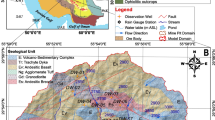Abstract
In Northern Iran paddy fields, waterlogging is a serious problem. Provision of subsurface drainage seems to be a prerequisite for optimal crop production. Considering specific characteristics of the paddies, application of a suitable equation for planning of subsurface drainage systems is of great importance. In this study, five steady-state equations including Hooghoudt, Kirkham, Dagan, Ernst, and Ernst–Hooghoudt; and three unsteady-state equations including Glover–Dumm, Van-Shilfgard, and De-zeeuw–Hellinga were implemented to compute drain spacing. Required field data were obtained from 52 ha of paddy fields of “Haraz Human-Agriculture Resources Development Center,” located in Mazandaran province of Iran. The computed drain spacings were evaluated using dynamic equilibrium concept and DRAINMOD model. The minimum and maximum drain spacings were found to be 26 and 63 m corresponding to Glover–Dumm and Ernst equations, respectively. Based on the dynamic equilibrium concept, the averages of the computed water table depths for the drain spacings obtained by the unsteady-state equations were 0.5–0.63 m as compared with those obtained by the steady-state methods which were in the range of 0–0.43 m. According to the DRAINMOD model simulations, the maximum relative yield was 80.2 % which was obtained when the drain spacing was 26 m and it reduced to 73.5 % when the drain spacing was increased to 63 m. The computed drain spacings suggested by the unsteady-state equations were found to be more suitable than those obtained from the steady-state equations for the study area.








Similar content being viewed by others
References
Ale S, Bowling LC, Brouder SM, Frankenberger JR, Youssef MA (2009) Simulated effect of drainage water management operational strategy on hydrology and crop yield for Drummer soil in the Midwestern United States. Agric Water Manag 96:653–665
Ayars JE, Christen EW, Hornbuckle JW (2006) Controlled drainage for improved water management in arid regions irrigated agriculture. Agric Water Manag 86:128–139
Cooper JR, Fouss JL (1988) Rainfall probability forecasts used to manage a subdrainage-subirrigation system for watertable control. Agric Water Manag 15:47–59
Cox JW, McFarlane DJ, Skaggs RW (1994) Field evaluation of DRAINMOD for predicting waterlogging intensity and drain performance in South-Western Australia. Aust J Soil Res 32:653–671
Darzi A, Ejlali F, Ahmadi MZ, Najafi G (2007) The suitability of controlled drainage and subirrigation in paddy fields. Pak J Biol Sci 10(3):492–497
Garg KK, Das BS, Safeeq M, Bhadoria PBS (2009) Measurement and modeling of soil water regime in a lowland paddy field showing preferential transport. Agric Water Manag 96:1705–1714
Halbac-Cotoara R (2009) Results obtained in drainage arrangements designed by using drainspace application. Res J Agric Sci 41(1):426–431
Oosterbaan RJ (1994) Agricultural drainage criteria. In: Ritzema HP (ed) Drainage principles and applications, ILRI publication 16, 2nd edn. Wageningen, The Netherlands
Oosterbaan RJ (2002) Drainage research in farmer fields: analysis of data, part of project “Liquid Gold” of the International Institute for Land Reclamation and Improvement (ILRI). Wageningen, The Netherlands
Ritzema HP (1994) Subsurface flows to drains. In: Ritzema HP (ed) Drainage principles and applications ILRI Publ. 16. Wageningen, The Netherlands, pp 283–294
Salazar O, Wesstrom I, Youssef MA, Skaggs RW, Joel A (2009) Evaluation of the DRAINMOD–N II model for predicting nitrogen losses in a loamy sand under cultivation in south-east Sweden. Agric Water Manag 9(6):267–281
Singh PK, Singh OP, Jaiswal CS, Chauhan HS (1999) Subsurface drainage of a three layered soil with slowly permeable top layer. Agric Water Manag 42:97–109
Singh R, Helmers MJ, Qi Z (2006) Calibration and validation of DRAINMOD to design subsurface drainage systems for Iowa’s tile landscapes. Agric Water Manag 85:221–232
Singh R, Helmers MJ, Crumpton WG, Lemke DW (2007) Predicting effects of drainage water management in Iowa’s subsurface drained landscapes. Agric Water Manag 92:162–170
Skaggs RW (1980) Drainmod reference report, methods for design and evaluation of drainage water management systems for soils with high water tables. USDA, SCS, North Carolina State University, Raliegh, p 185
USBR (US Bureau of Reclamation) (1978) Drainage manual. US Gov. Printing Office, Washington, DC
van Beers WFJ (1976) Computing drain spacing, a generalized method with special reference to sensitivity analysis and geo-hydrological investigations. International Institute for Land Reclamation and Improvement/ILRI, Bulletin 15, p 32
Wang X, Mosley CT, Frankenberger JR, Kladivko EJ (2005) Subsurface drain flow and crop yield predictions for different drain spacings using DRAINMOD. Agric Water Manag 79:113–136
Yang X (2008) Evaluation and application of DRAINMOD in an Australian sugarcane field. Agric Water Manag 95:439–446
Acknowledgments
The authors would like to thank Iran–Japan project in northern Iran (CAPIC) for giving their site for the investigation.
Author information
Authors and Affiliations
Corresponding author
Rights and permissions
About this article
Cite this article
Darzi-Naftchally, A., Mirlatifi, S.M. & Asgari, A. Comparison of steady- and unsteady-state drainage equations for determination of subsurface drain spacing in paddy fields: a case study in Northern Iran. Paddy Water Environ 12, 103–111 (2014). https://doi.org/10.1007/s10333-013-0364-4
Received:
Revised:
Accepted:
Published:
Issue Date:
DOI: https://doi.org/10.1007/s10333-013-0364-4




